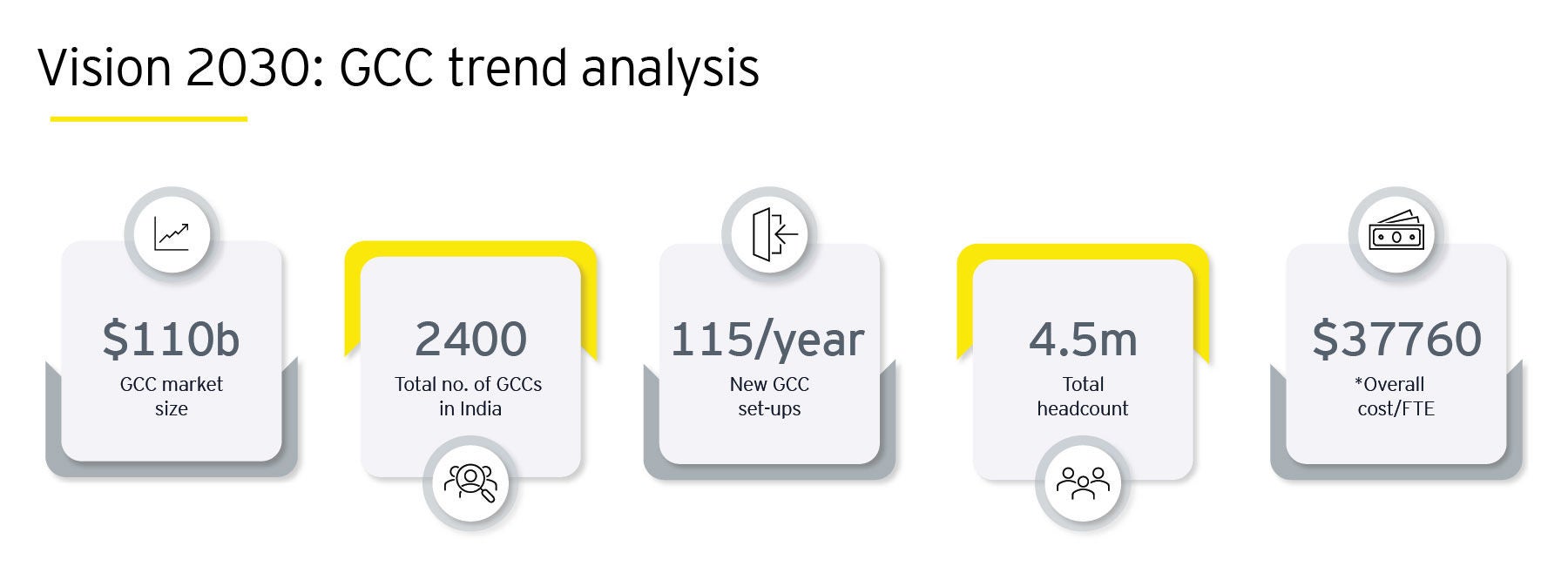EY refers to the global organization, and may refer to one or more, of the member firms of Ernst & Young Global Limited, each of which is a separate legal entity. Ernst & Young Global Limited, a UK company limited by guarantee, does not provide services to clients.

Primary factors contributing to GCC market size expansion
1. Increase in software exports services
Having an India-based GCC is no longer considered a mere labor arbitrage move, but a must for digital transformation, innovation, and value-added operations. As a result, multinational corporations across the globe are looking at India as a prime location to establish or expand their operations. One of the key drivers for this growth includes software exports, which remain a key component of India's service exports, with offshoring services seeing continued growth.
2. Tier 2 cities catching the attention of GCCs
The report suggests that by 2030, the overall number of new GCC establishments each year could reach 115 from the current 70. While Bengaluru, Hyderabad, Chennai, Mumbai, Pune, and Delhi NCR remain popular sites for GCC establishments in India, tier-II cities are also grabbing the interest of GCC leaders. Cities such as Visakhapatnam, Jaipur, Vadodara, Kochi, Chandigarh are becoming popular for new set-ups owing to its improving infrastructure, favorable state policies, and lower real estate and talent costs. Coimbatore in particular is emerging as the next big GCC hub post Chennai in Tamil Nadu.
3. Collaboration with a thriving start-up ecosystem
India is the world's third largest ecosystem for start-ups2. In this backdrop, it provides an opportunity for GCCs and start-ups to collaborate, accelerating the entire innovation journey. While start-ups benefit from market access, enterprise connect, mentoring, funding, and data, GCCs receive technology with due diligence, speedier go-to-market, accelerated innovation, and tech-driven talent.
4. The growth in GCC talent pool
India is one of the top tech talent markets globally3. It is no surprise then that by 2030, the GCC industry is expected to comprise over 4.5 million people, compared to the current base of ~1.9 million. As talent remains a competitive advantage, organizations must invest in their organizational culture and improve their employee value proposition.
Also, GCCs’ rising overall cost per FTE4, from the current level of US$29,100 to US$37,760 by 2030. GCCs are expanding their services with a focus on innovation and knowledge-based capabilities, leading to increased costs. The focus now is on balancing high costs with value delivered, especially in dynamic economic conditions.
The top GCC trends for the year include:
- Establishment of Centres of Excellence (CoEs) in areas such as artificial intelligence (AI), cloud computing, engineering, data analytics, and cybersecurity
- Transitioning from a 'cost centre' to a 'profit center,' with a focus on generating additional revenue streams
- Expansion of functions in areas such as legal, marketing, and procurement with increased investments
- Greater emphasis on Employee Value Proposition (EVP) to supplement key areas of focus such as organizational culture, nature of work, rewards and compensation








